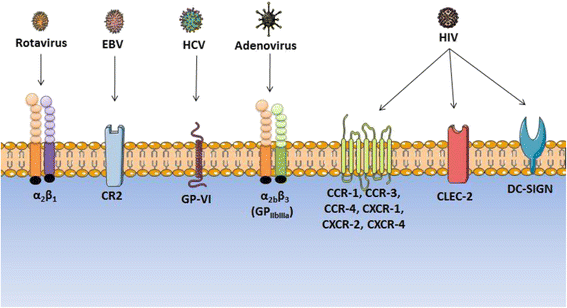Human platelets and their capacity of binding viruses: meaning and challenges?
- PMID: 25913718
- PMCID: PMC4411926
- DOI: 10.1186/s12865-015-0092-1
Human platelets and their capacity of binding viruses: meaning and challenges?
Abstract
Blood platelets are first aimed at ensuring primary hemostasis. Beyond this role, they have been acknowledged as having functions in the maintenance of the vascular arborescence and, more recently, as being also innate immune cells, devoted notably to the detection of danger signals, of which infectious ones. Platelets express pathogen recognition receptors that can sense bacterial and viral moieties. Besides, several molecules that bind epithelial or sub-endothelial molecules and, so forth, are involved in hemostasis, happen to be able to ligate viral determinants, making platelets capable of either binding viruses or even to be infected by some of them. Further, as platelets express both Fc-receptors for Ig and complement receptors, they also bind occasionally virus-Ig or virus-Ig-complement immune complexes. Interplays of viruses with platelets are very complex and viral infections often interfere with platelet number and functions. Through a few instances of viral infections, the present review aims at presenting some of the most important interactions from pathophysiological and clinical points of view, which are observed between human viruses and platelets.
Figures

Similar articles
-
Platelets and viruses.Platelets. 2021 Apr 3;32(3):325-330. doi: 10.1080/09537104.2021.1887842. Epub 2021 Feb 22. Platelets. 2021. PMID: 33615982 Free PMC article. Review.
-
Platelets and viruses: an ambivalent relationship.Cell Mol Life Sci. 2010 Feb;67(4):545-56. doi: 10.1007/s00018-009-0209-x. Epub 2009 Dec 12. Cell Mol Life Sci. 2010. PMID: 20012669 Free PMC article. Review.
-
The role of platelets in defence against pathogens.Hamostaseologie. 2011 Nov;31(4):264-8. doi: 10.5482/ha-1152. Epub 2011 Jun 28. Hamostaseologie. 2011. PMID: 21709931
-
[Blood platelets and biological response to 'danger' signals and subsequent inflammation: towards a new paradigm?].Transfus Clin Biol. 2011 Apr;18(2):165-73. doi: 10.1016/j.tracli.2011.02.012. Epub 2011 Mar 27. Transfus Clin Biol. 2011. PMID: 21444230 Review. French.
-
Innate recognition of viruses.Immunol Lett. 2010 Jan 18;128(1):17-20. doi: 10.1016/j.imlet.2009.09.010. Epub 2009 Oct 4. Immunol Lett. 2010. PMID: 19808054 Review.
Cited by
-
Post-Transcriptional Expression Control in Platelet Biogenesis and Function.Int J Mol Sci. 2020 Oct 15;21(20):7614. doi: 10.3390/ijms21207614. Int J Mol Sci. 2020. PMID: 33076269 Free PMC article. Review.
-
Hematological Abnormalities in COVID-19 Disease: Association With Type I Interferon Pathway Activation and Disease Outcomes.Front Med (Lausanne). 2022 Mar 17;9:850472. doi: 10.3389/fmed.2022.850472. eCollection 2022. Front Med (Lausanne). 2022. PMID: 35372456 Free PMC article.
-
Platelets Endocytose Viral Particles and Are Activated via TLR (Toll-Like Receptor) Signaling.Arterioscler Thromb Vasc Biol. 2020 Jul;40(7):1635-1650. doi: 10.1161/ATVBAHA.120.314180. Epub 2020 May 21. Arterioscler Thromb Vasc Biol. 2020. PMID: 32434410 Free PMC article.
-
Promoting platelets is a therapeutic option to combat severe viral infection of the lung.Blood Adv. 2020 Apr 28;4(8):1640-1642. doi: 10.1182/bloodadvances.2020001669. Blood Adv. 2020. PMID: 32315397 Free PMC article. No abstract available.
-
Acetylsalicylic acid differentially limits the activation and expression of cell death markers in human platelets exposed to Staphylococcus aureus strains.Sci Rep. 2017 Jul 17;7(1):5610. doi: 10.1038/s41598-017-06024-2. Sci Rep. 2017. PMID: 28717145 Free PMC article.
References
-
- Zucker-Franklin D, Seremetis S, Zheng ZY. Internalization of human immunodeficiency virus type I and other retroviruses by megakaryocytes and platelets. Blood. 1990;75(10):1920–3. - PubMed
Publication types
MeSH terms
LinkOut - more resources
Full Text Sources
Other Literature Sources
Medical

